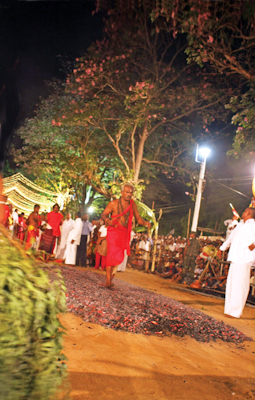
Every year in the month of July or August, Kataragama throbs with life. A site of pilgrimage for all faiths, this city located in the southeast coast of Sri Lanka, is always crowded but during the annual festival it becomes a seething mass of people. A huge number of people from all over the island travel to Kataragama, drawn by the annual festival and Perahera.
The Perahera is preceeded by the kap situweema ceremony which is held approximately 45 days before the festival begins. The inaugural Perahera commences at the auspicious time with the cracking of whips and sound of drumming. Perahera means procession and that is exactly what it is; a procession with a multitude of dancers, drummers and flag bearers. Like all Peraheras in Sri Lanka, the elegantly decorated elephants are a highlight that always draws attention. Drummers and dancers step among the elephants and fire from hand held torches illuminates the pageant, turning Kataragama into a whirlwind of activity. For the visitor it’s a kaleidoscope of colours, rhythm and motion.
A notable feature is the use of the kaavadi, an arched pole decorated with coloured paper and peacock feathers. Pilgrims carry these kaavadi on their shoulders, while stepping or dancing to the sound of drumming. Many are not professional dancers, but perform as the fulfilment of a vow. Infliction of physical pain for atonement of sins are part of the rituals at Kataragama; some pilgrims pierce their lips, cheeks or tongue with silver arrow-headed pins. Others hang suspended from beams or dragging carts through hooks pierced in their backs.
The Perahera begins on July 1 and from the sixth day onwards the Perahera will take place with the participation of the Basnayake Nilame of the Ruhunu Maha Kataragama Devale. From July 1-14 the Perahera will proceed from the Maha Devale to the Valli Amma Devale and proceed back along Main Street to the Maha Devale again. The final Perahera on the night of July 15 will proceed from the Maha Devale upto the Kiri Vehera, then back to the Valli Amma Devaleand from there back to the Maha Devale.
One of the most well known parts of the festival is the fire-walking ceremony where pilgrims walk over a mass of embers raised by burning logs. Devotees claim that their faith prevents them from harm when stepping on the hot embers. The Perahera ends with the water cutting ceremony with the plunging of a sword into the waters of the Menik Ganga, all peraheras traditionally end with this ceremony.
A preamble to the Kataragama festival is the Pada Yatra, where pilgrims travel on foot for long distances making the pilgrimage to Kataragama. The distinctive cry of “Haro Hara” raised by pilgrims rends the air as they make their journey. Traditionally the Pada Yatra starts from a point in the Jaffna peninsula such as the Nallur Kovil. Devotees may take several months to reach Kataragama, travelling through Kumana national park on their way. It is an arduous journey and pilgrims depend on the hospitality of strangers, accepting alms, walking barefoot and sleeping in temples or under the open sky.
Even though Kataragama is so well known its origins still remain something of an enigma. Each religion claims it for its own, perhaps therein lies its appeal. The interesting thing is that this creates no friction, each worshipper considers himself or herself privileged in his or her belief.
Many traditions and beliefs surround Kataragama. According to Prof Senarath Paranavithana, Buddhists believe that Kataragama is one of the places visited by Lord Buddha and thus consider it a site of pilgrimage. Hindus revere it as the abode of Lord Skanda, the god of war. Skanda is known by many names, Kataragama, Murugan, Kartikeya, to name a few, and has a strong following among many Buddhists as well as Hindus, a reflection of the way the religions have influenced each other. Many shrines exist all over the country, associated with the Kataragama god which are visited by both Buddhists and Hindus alike. Kataragama is also a site of pilgrimage for Muslims. The Kataragama god has also long been worshipped by the Veddah (indigenous) community who refer to him as Kanda Yaka.
To most pilgrims who make the long walk down though, reasons seem to be largely irrelevant, their driving force is belief not reason. Every year throngs of people arrive. It was not always so. Dr John Davy for one would have been surprised. A British visitor who came to Kataragama in 1819, he then observed, “The number of pilgrims is now annually diminishing, and the buildings are going to decay. In a very few years, probably…the traveller will have difficulty in discovering their site.” Time could not have proved him more wrong.
This year the Kataragama Perehera will be held from July 1 for two weeks ending with the water cutting ceremony on July 16.
Ruhunu Maha Kataragama Devale Tel: (+94 47) 223 5122
[nggallery id=50]

